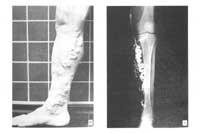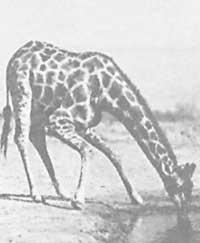Varices, ugly and dangerous
1988/08/01 Ibarguren Olalde, Karlos Iturria: Elhuyar aldizkaria
Introduction Introduction Introduction Introduction
Before beginning to explain what varices are, it is necessary to clarify some concepts. Let us therefore begin to see the differences between the artery and the vein. The arteries are tubes that carry blood from the heart to tissues throughout the body. Benes, however, return blood to the heart of the tissues of the body.
It is also important to have clear the idea that the arteries do not join each other. Not in normal conditions. Between both there are capillaries.
Therefore, to clarify more the ideas: the arteries carry clean blood to all the tissues of our body, which are distributed in chapels and when the veins are collected. As the wall of the chapels is very thin, in it the blood will leave O 2 and food and will receive CO 2 and residues of the cells of the different tissues, causing the clean blood to become dirty. This dirty blood will go through the veins to the lungs after passing through the heart, leaving there O 2 and the CO 2 it carries.
Although we anticipate ideas, let's say that varicose veins are a true disease. In addition, with greater precision, it is usually a venous leg disease. The consequence of this disease is that poisons do not perform their function properly, that is, they do not transport blood to the heart properly accumulating it in the legs.
Two systems of vein
Before moving forward we have to clarify another idea, another idea that must be understood by the desires to dominate the subject.
In our legs there are two venous systems: the superficial and the deep.
In addition, the superficial venous system consists of two main veins:

Internal safena: It forms inside the ankle and goes up the inside of the leg to the thigh, where the system is added thoroughly.
External Safena: It forms on the outside of the ankle and rises from the back of the leg to the empty postponement (back hole of the knee), where the system is added to the depth.
The deep vein system, as its name suggests, runs its way from the depth (i.e., the muscle), passing the entire leg through its path.
Therefore, the varices that we see are those produced by the veins of the superficial system. This does not mean that they do not appear in a deep system, but, although we note them, we will not see them.
How does the blood work?
What drives the blood to move through these tubes? In the case of arteries the answer is simple: The strength or pressure exerted by the heartbeat. But in the case of the reals, the thing is not so simple, since there are factors that are important:
- Heartbeat: Heartbeat: Although it has lost strength in arteries and capillaries, it is still important. Negative pressure on the chest. Muscle contractions: The muscle contraction of our legs will be important. Therefore, it is clear that walking and sport will normally be good.
- Valve systems: Our veins have some valves. This makes the blood only move toward the heart, without going back. In pipes that communicate with the deep surface system also appear valves. That is why the blood can go to the depth, but not the other way around.
It is clear that anything that prevents any of these four factors can turn the varicose veins, as it will cause the blood to accumulate in the legs.
What are varicose veins?
After these basic general explanations, let's see what varices really are, and know something more about them.
A vein, to be considered as a varix, should appear extended, stretched and wavy.
On the other hand, to say that the pathology is very abundant, will not be unknown to anyone. They usually appear around the age of 18 to 30 years, with the following distribution: 30% in men and 45% in women.
It seems that one of the causes of greater appearance in women is pregnancy.
At this point it is necessary to perform a classification of varicose veins. As we will see, there are several types: primary, successors of thrombophlebitis, descendants of arteriovenous fistula, by the barrier of the deep system.
Primary Education Primary Education Primary Education Primary Education Primary Education Primary Education
Here the damage would be congenital. The above mentioned valve system would not do well with its work, so blood, instead of going to the heart, would go backwards. In addition, the blood would pass from a deep to a superficial system and its veins would expand.
But, why are they not born or appear in younger people? It seems that in young people this damage is compensated by the work done by the muscles. In addition, an adult has spent many hours standing, has had pregnancies, etc...
Successors of thrombophlebitis
Without going into the study of what thrombophlebitis is, we will let it be said that it is intravascular coagulation that hinders the deep system. Not being able to circulate blood in a deep system will pass through the superficial system. Therefore, it is clear that in this case we will not be able to remove the poisons that make up the surface system. If not, the blood would not find a way to return to the heart and accumulate in the legs.
Successors of the artero-vein fistula
We mentioned earlier that capillary appear between the arteries and veins. If for any reason a short circuit occurs without going through these capillaries, the blood will reach the vein at high pressure, extending it.
Background system by barrier
If, in any circumstance, the circulation of this system is difficult, the blood will circulate through the surface system.
The obstacles can be of various types: Binding of veins in a surgical operation, a tumor that presses veins, consistency...
Clinical signs and symptoms Clinical signs
The main signs are very clear, usually the same patient carries a diagnosis.
The first sign is the wavy extension of the veins. Below are the heavy legs and tiredness, which are sharpened with the standing position and improve with the presence of aratines (lying face-up), especially with the legs.
Over time, dilation will increase, edema, cyanosis, pigmentation and ulcerations will appear.
Discomfort increases heat and, of course, pregnancy.
Conclusions of varices
But what is the problem of varicose veins? Is it only aesthetic? Besides the aesthetic problems presented by varicose veins, there are other dangers, among which three stand out.
Bleeding: Bleeding: The wall of the variz is less robust than that of the other tubes. Therefore, they break easily without any blow or with very small blows.
Thrombophlebitis: In these strange ducts the blood is more easily cooked.
Pulmonary embolism: These thrombi that have been created previously can pass through the vena cava to the lungs. There it will remain in a thinner tube without letting blood pass. The conclusion is that it is nothing good. However, this complication is very rare.
Treatment of treatment Treatment
Before starting treatment, let's see what measures can be taken to delay its evolution:
- In case of venous insufficiency, compressor bandages or elastic pantys may be placed. You have to spend as little time as possible standing, lying down and raising your legs. Control the consistency. Use little salt in meals. Lift the part of the legs of the bed with tacos of about 14-15 cm.
- It can also be convenient to use beneficial tonics and some kind of diuretic, all under medical control.
But when they have appeared, what to do? Despite the different treatments, it is very important to emphasize that without ensuring that the system is exhaustively permeable, varices will never be eliminated.
The most used techniques are:
Striping: In a nutshell, it consists of putting a rod inside the vein and expelling the vein through it.
Elimination of sclerosing substances introduced inside the vein.
Combined technique: It would be the sum of the previous two.
They can also be removed surgically one by one.
There are others, but it seems enough to know them.
That is, in a nutshell, what we can express above all about the genesis and evolution of varicose veins. For the benefit of our health, we should all consider this problem.

Gai honi buruzko eduki gehiago
Elhuyarrek garatutako teknologia



